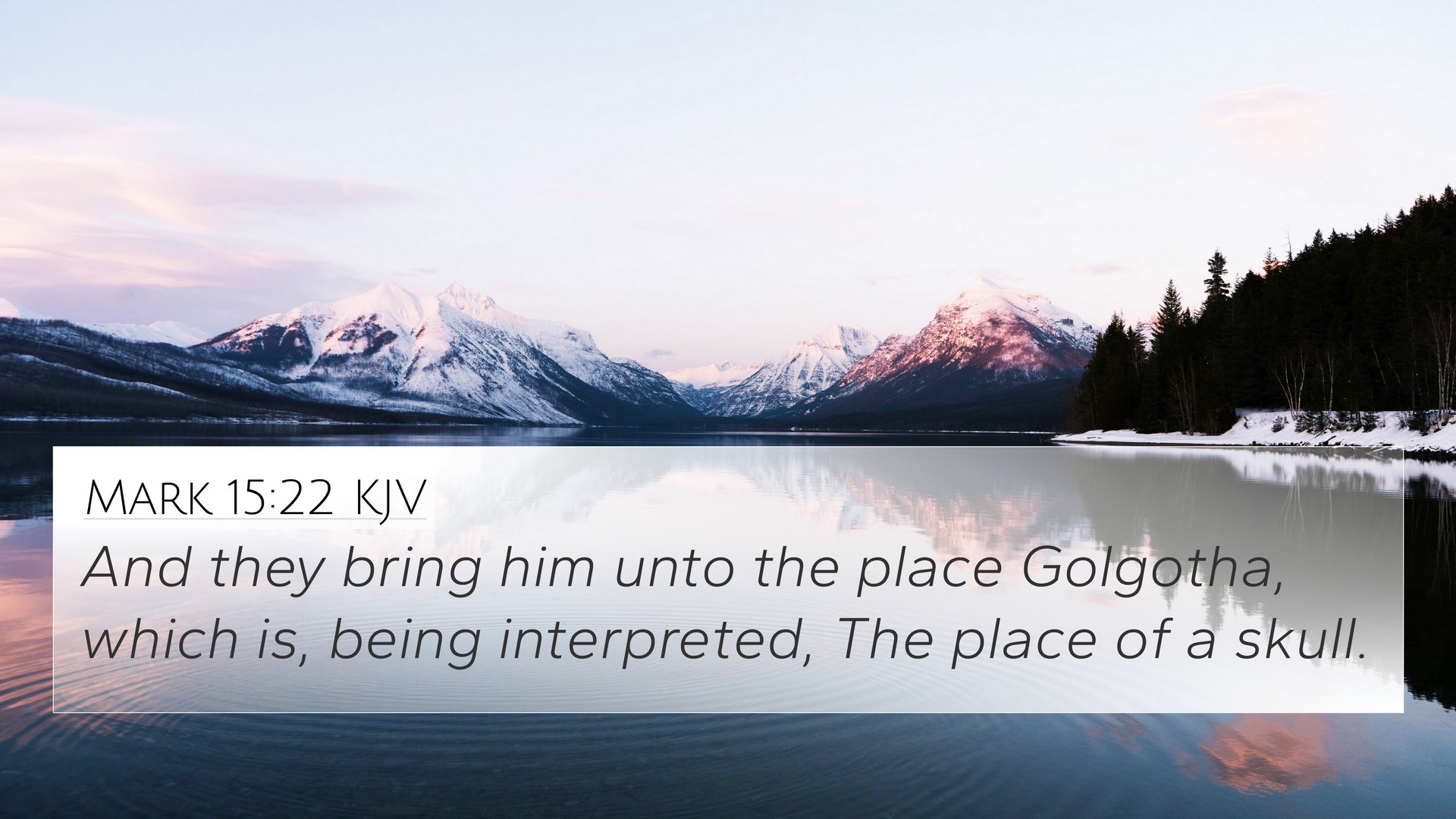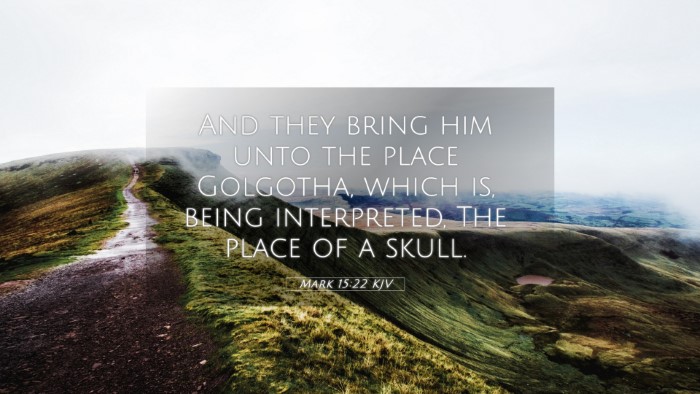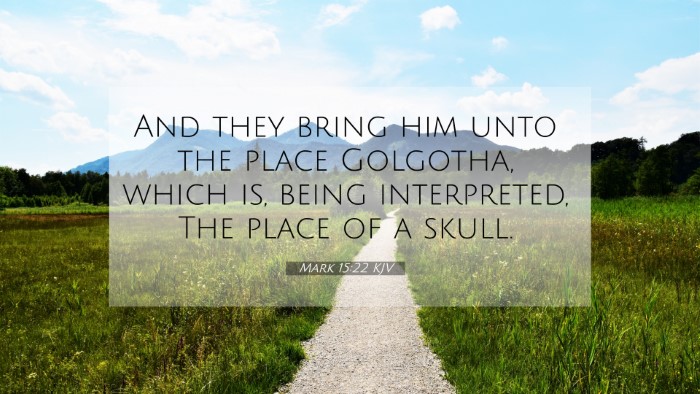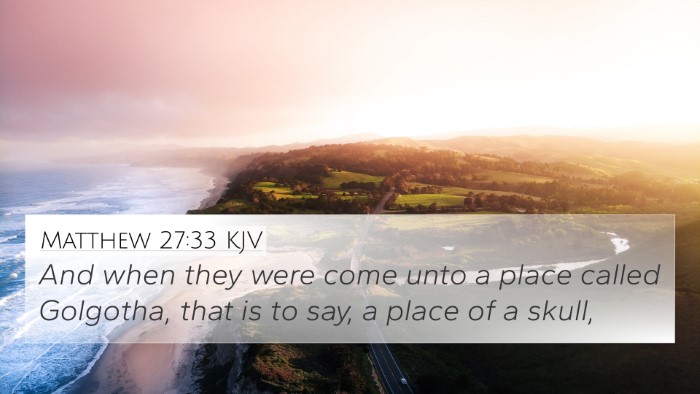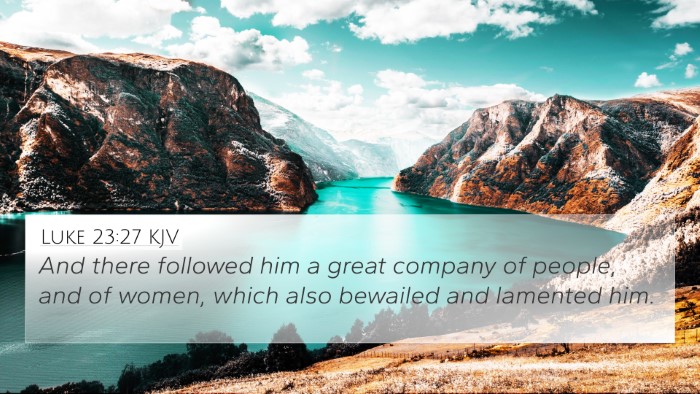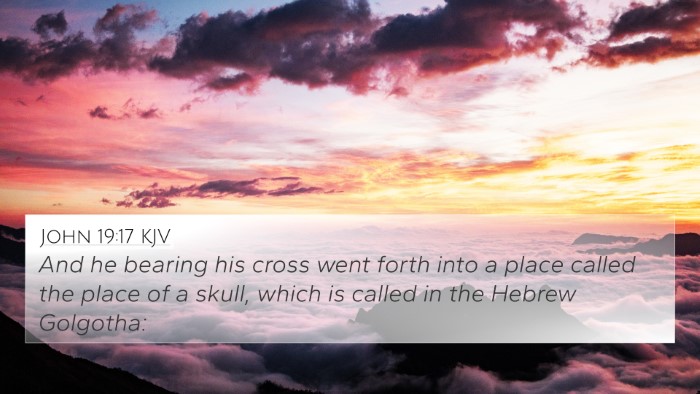Bible Verse Meaning: Mark 15:22
Verse: “And they brought Him to the place Golgotha, which is translated, Place of a Skull.” (Mark 15:22)
Summarized Meaning
Mark 15:22 presents the moment when Jesus is led to Golgotha, known as the Place of the Skull, a place where He is to be crucified. This pivotal event signifies not just the physical act of crucifixion but encapsulates deeper theological implications regarding sacrifice, atonement, and the fulfillment of prophecies. It represents the culmination of Christ's mission on Earth, where His suffering becomes the gateway to salvation for humanity.
Bible Verse Cross-References
- Matthew 27:33: References the same location, providing further context about the crucifixion.
- John 19:17: Another Gospel that mentions the journey to Golgotha, emphasizing His burdens.
- Luke 23:33: Further details the event at Golgotha, highlighting the significance of the criminals alongside Christ.
- Psalm 22:1: A prophetic psalm that foreshadows the crucifixion experience.
- Isaiah 53:5: Discusses the suffering servant, paralleling the themes of suffering and atonement.
- Hebrews 13:12: Connects the death of Jesus outside the gate to the sacrificial system of the Old Testament.
- Galatians 6:14: Speaks to the glory of the cross, affirming its central place in Christian faith.
Insights from Public Domain Commentaries
Matthew Henry: He emphasizes that Golgotha is significant for its grim and repulsive name, illustrating the horror of sin leading to death. The place acts as a backdrop for ultimate sacrifice.
Albert Barnes: Comments on Christ's journey to Golgotha, highlighting that this act of being brought to the cross signifies His fulfilling the prophecy and His mission of salvation through suffering.
Adam Clarke: Adds depth by reflecting on the interpretation of "Place of the Skull," which has been linked to death and mortality, representing not only the physical place of Christ's execution but also the larger cosmic reality of sin and redemption.
Thematic Connections
This verse highlights various themes such as sacrifice, suffering, and redemption. It connects both the Old and New Testaments through the shared narrative of salvation history.
In the light of cross-referencing Bible texts, the event at Golgotha resonates with themes found throughout Scripture:
- Suffering Servant: Isaiah’s prophecies about the coming Messiah who suffers for the sins of many resonate deeply with Jesus' experience at Golgotha.
- Redemptive Sacrifice: Established in the sacrificial system in Leviticus, the ultimate sacrifice of Christ fulfills these Old Testament types and shadows.
- Fulfillment of Prophecy: The act of being led to the cross was prophesied, demonstrating God's meticulous plan of redemption that spans generations.
Comparative Bible Verse Analysis
Examining Mark 15:22 alongside other Gospel accounts reveals nuances in the portrayal of events leading to the crucifixion:
- Matthew vs. Mark: While both Mark and Matthew depict the event similarly, Matthew highlights the crowd's participation, adding emotional weight to the narrative.
- Synoptic Relationships: John provides unique details about the burden Jesus bore, fostering a deeper understanding of His human experience during the journey to Golgotha.
Inter-Biblical Dialogue
The mention of Golgotha evokes conversations between the Old and New Testament, showcasing how themes of death and resurrection interact:
- Death and Resurrection: The cross points forward to the resurrection; where death meets hope, emphasizing the victory of Christ over sin.
- Hope in Prophecy: The anticipation of the Messiah in the Psalms and Isaiah reaches its climax in the events of the crucifixion, interconnecting the Old Testament hopes with New Testament realities.
Using Bible Cross-References
Learning how to navigate cross-references enhances understanding of the Bible’s interconnectedness:
Tools such as a Bible concordance and a cross-reference guide can help identify connections between verses like Mark 15:22 and other related scriptures.
For deeper study, employing methods like comparative analysis or thematic groupings can yield rich insights into passages that relate to the crucifixion and its implications for believers today.
Conclusion
The depiction of Golgotha as noted in Mark 15:22 represents far more than a simple geographical location; it is the epicenter of the Christian faith, encapsulating the themes of sacrifice, redemption, and fulfillment of prophecy. By exploring cross-references and understanding inter-Biblical dialogues, believers can deepen their grasp of Scripture, linking passages that enrich their theological insights and personal faith journeys.
